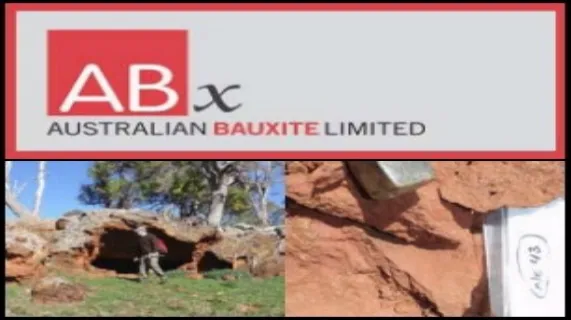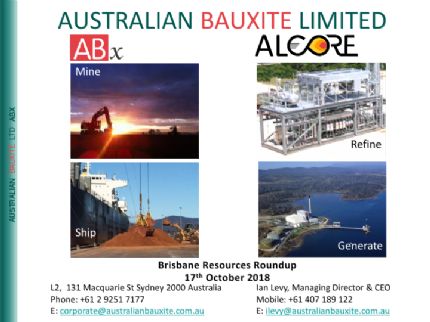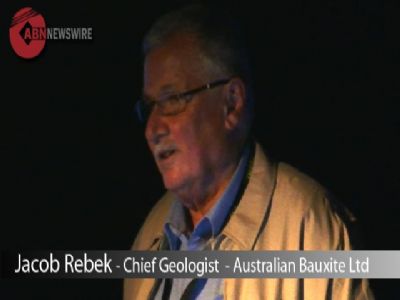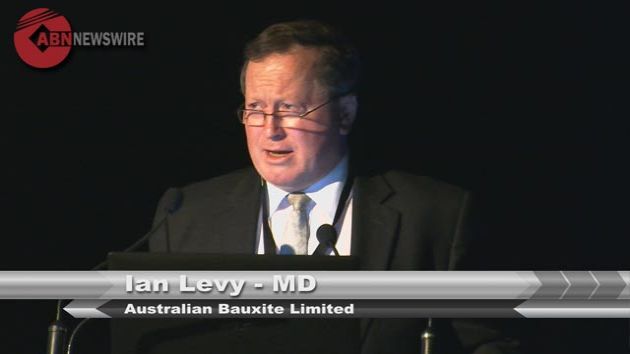
Australian Bauxite Limited (ASX:ABZ) Announce 16.8 Million Tonnes Maiden Binjour Resource
Sydney, Oct 12, 2011 AEST (ABN Newswire) - Emerging bauxite exploration and development company, Australian Bauxite Limited ( ASX:ABZ) ("ABx") has discovered a thick layer of very high quality bauxite at its Binjour project in central QLD. The bauxite lies beneath a clay horizon. Results from 88 holes into the bauxite are generally exceptionally high grade, thick gibbsite bauxite, ideal as a "sweetener" to any bauxite refinery. ABx refers to such high grade bauxite as "Brown Sugar" which commands a large price premium.
ASX:ABZ) ("ABx") has discovered a thick layer of very high quality bauxite at its Binjour project in central QLD. The bauxite lies beneath a clay horizon. Results from 88 holes into the bauxite are generally exceptionally high grade, thick gibbsite bauxite, ideal as a "sweetener" to any bauxite refinery. ABx refers to such high grade bauxite as "Brown Sugar" which commands a large price premium.
Resource estimates after application of cut-off grades for the drilled resource areas on the initial deposits tested at Binjour are summarised as follows, see link: http://media.abnnewswire.net/media/en/docs/ASX-ABZ-652373.pdf
The Binjour deposit lies near the top of a plateau which has been widely cleared for farming but large parts are now left uncultivated because of the dry, poor soil that develops on bauxite.
The bauxite in the resource area is consistently high quality and most is "Brown Sugar" bauxite, being a superior quality, low silica, gibbsite bauxite suitable for sweetening circuits in refineries.
New areas of bauxite have been discovered in recent months and are currently being drilled to expand resource extent.
Hole Legend:
Red diamonds (solid) = High grade holes
Red diamonds (open) = Resource holes
Grey dots = subgrade bauxite or no bauxite
Resource Outlines:
Blue lines = High grade bauxite
Red lines = Bauxite resources
Comments about bauxite distribution
High grade bauxite results from a further 13 holes were received after the resource estimation process was well-in-hand. These will be included in the next Binjour resource update.
In places, otherwise good bauxite is rendered subgrade due to the presence of a white gelatinous-clay substance in the bauxite. Tests are underway to find a way to remove this material by simple washing methods.
If, after low cost washing, this material subsequently becomes bauxite-resource grade, the extent and continuity of Binjour bauxite resources will expand materially.
Recent discoveries of bauxite in outcrops suggests that several of the irregular resource outlines may coalesce into sizeable resource blocks when drilled in future.
Detailed mapping and reinterpretations suggest that there may be more than one bauxite layer at Binjour.
Additional drill rods are being sourced so that the geometric distribution of bauxite can be better defined.
Regional exploration has found more bauxite in the district - these areas are being assessed.
Core Zone of Very High Grade Bauxite
As part of this resource estimation process, a high-grade core zone of bauxite was identified and estimated to total 9.3 million tonnes as follows:
Should a project commence at Binjour, mining would probably commence on such material.
Logistical Setting
The Binjour bauxite project is located approximately 160kms inland from Bundaberg port. Australian Bauxite Limited is participating in a major transport study of the region to assess the alternative ways to transport this high quality bauxite to markets, either in Australia or overseas.
Further Work Planned
The bauxite deposit is open in many locations and many other deposits have been identified. Followup drilling of the Binjour plateau (25km x 10km in area) and surrounding new prospects is being scheduled over the coming months.
New Exploration Permit Applications
The bauxite deposit is concealed beneath a shallow surface clay layer but the company's exploration technology indicates that this high quality bauxite layer extends over a considerable distance. A new exploration permit application has been made to secure the extension areas for ABx. Once approved, exploration will accelerate even more in the Binjour district.
GROWTH IN TOTAL BAUXITE RESOURCES OVER TIME
In the 21 months since listing on the ASX on 24 December 2009, Australian Bauxite Limited has discovered, drilled and declared bauxite resources totalling 84 million tonnes 1,2,3,4, mainly of highquality, low silica gibbsite rich bauxite. The resource growth has already exceeded the company's target for calendar 2011 and shows no sign of slowing across the 37 tenements in QLD, NSW & Tasmania.
RESOURCE ESTIMATE METHOD
Reconnaissance and follow-up exploration drilling was done on a semi-random pattern governed by site availability across Binjour EPM 18014 and Binjour Extension EPM 18772 to test several of the many bauxite targets. By 30 September, 88 holes had intersected a consistently good quality bauxite layer concealed beneath a surface clay layer. High grade bauxite results from a further 13 holes arrived too late to be incorporated in this maiden resource estimation.
Drill samples were collected at 1 metre intervals from the aircore drillholes and analysed at ALS Laboratories in Brisbane including trihydrate (THA) available alumina ("Al2O3 Avl") and reactive silica ("Rx SiO2") measurements. Leach conditions to measure available alumina "Al2O3 Avl" and reactive silica "Rx SiO2" were 1g leached in 10ml of 90gpl NaOH at 143 degrees C for 30 minutes.
Estimation was done by geostatistical block modelling of bauxite intercepts, constrained within geological boundaries using Gemcom resource estimation software. The block size is 25m x 25m and drill spacing within the bauxite zones was typically at 75 to 150 metres spacings. Data interpolation of up to 300 metres was done, based on statistical assessments of continuity. Blocks with less than 5 datapoints within that 300 metre search ellipse were classified as Inferred Resources and the more heavily drilled blocks were classified as Indicated Resources.
Bauxite density was conservatively assumed at 1.85 dry tonnes per cubic metre in situ even though this bauxite layer is generally unweathered due to protection from the overlying clay layer.
About ABx Group Limited
 ABx Group Limited (ABx) (ASX:ABX) started as a bauxite miner in Tasmania in 2014 & controls the Eastern Australian Bauxite Province. In 2020 to 2023, ABx also discovered Australia’s only true ionic adsorption clay Rare Earth Elements resource at Deep Leads in pine plantations 40km west of Launceston with a JORC-compliant resource of 89 million tonnes from only 29% of the mineralised outline, averaging 844 ppm total rare earth oxides that is the most enriched in the critically important rare earths, Dy and Tb, of any Australian REE deposit.
ABx Group Limited (ABx) (ASX:ABX) started as a bauxite miner in Tasmania in 2014 & controls the Eastern Australian Bauxite Province. In 2020 to 2023, ABx also discovered Australia’s only true ionic adsorption clay Rare Earth Elements resource at Deep Leads in pine plantations 40km west of Launceston with a JORC-compliant resource of 89 million tonnes from only 29% of the mineralised outline, averaging 844 ppm total rare earth oxides that is the most enriched in the critically important rare earths, Dy and Tb, of any Australian REE deposit.
ABx has also developed a proprietary technology to produce fluorine chemicals from an aluminium smelter waste product and return the fluorine back into the smelters, thus reducing reliance on imported aluminium fluoride.
ABx has committed a large proportion of its expenditure into Research and Development and has found ways to capitalise on the main strengths of its bauxite type which is very clean, free of all deleterious elements and can be separated into different product streams using physical, chemical and geophysical methods. It has produced and marketed specialist bauxite products for the manufacturers of fertiliser, cement with high late strength for major infrastructure such as bridges and is in the advanced stages of approvals for production of metallurgical bauxite from its Binjour Bauxite deposit with JORC-compliant resources of 37 million tonnes of bauxite, in a joint development with a Chinese-focussed Australian trading company Good Importing International.
ABx is also preparing to produce fertiliser grade and cement grade bauxite from its DL130 bauxite quarry in northern Tasmania, 40km west of Launceston. This quarry is sited in the middle of the large Deep Leads REE deposit and may one day be a site for heap leaching of the REE using a low-cost, benign leachate with the same acidity as apple juice or tea.
ABx endorses best practices on agricultural land, strives to leave land and environment better than we find it. We only operate where welcomed.
| ||
|








